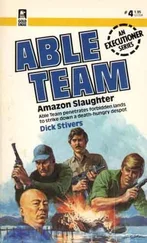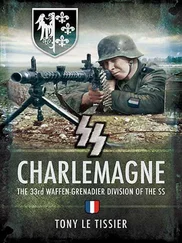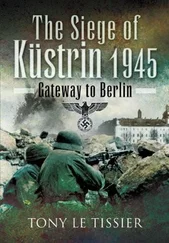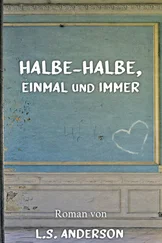In his diary, SS-Lieutenant Bärmann of the same unit gave some indication of the confusion arising out of the redeployment on the northern flank of 9th Army that day. He wrote that the battalion command post was first established in Bad Saarow that morning, then moved back east to Alt Golm. He conducted a reconnaissance of the road from Alt Golm to Saarow, finding the route blocked with troops of all kinds who did not know what was ahead of or behind them. He then drove west to Friedersdorf to try and locate Battlegroup Krauss (based on 32nd SS Division’s tank-hunting battalion) but it had already moved on. On his way he met SS-Captain Paul Krauss, commander of the battalion, in Niederlehme and went on with him to Wernsdorf. [17] Tieke, Das Ende zwischen Oder und Elbe , pp. 172–3.
Behind the lines, Märkisch Buchholz was declared a fortress and prepared for all-round defence. Of vital importance here were the three bridges leading out of the town where the River Dahme connected with the Dahme Flood Canal that helped drain the Upper Spreewald. One was on the Halbe road next to the weir on the upper stretch of the canal and two across the lower stretch leading into the Hammer Forest, one of which carried Reichstrasse 179.
Meanwhile a Waffen-SS unit occupied Halbe and expressed its intention to defend the village, come what may. The local Volkssturm unit had already prepared an anti-tank barrier on the east–west running high street, and another on the street south leading to Teurow. The inhabitants prepared for the coming fighting, realising that their village lay on the main route to the west. Many prepared dugouts in the woods around, or prepared to take to their cellars, while concealing their valuables by burying them in boxes. [18] Führling, Endkampf an der Oderfront , p. 105.
FOUR
Destroy the 9th Army
22 APRIL 1945
At 1100 hours on Sunday, 22 April, General Heinrici telephoned General Krebs to say that, unless 9th Army was allowed to withdraw, it would be split in two by nightfall. This time his words must have had some effect, for at 1450 hours Krebs telephoned back with permission for the Frankfurt Garrison to abandon the city and fall back on the 9th Army, thus allowing some adjustment to the army’s over-extended dispositions.
At this stage the 9th Army’s northern flank was still firm from Frankfurt to a Soviet bridgehead north of Fürstenwalde. From there a battlegroup of the 32nd SS Volunteer Grenadier Division 30. Januar provided a light screen as far as Wernsdorf at the western end of the Oder–Spree Canal.
That evening, with his normal supply routes severed, General Busse sent the following message to Army Group Weichsel :
Last possibility of resupply for the army checked by breach at Grünau. Thus initiated relief measures invalidated. Supply only by air or air drop. [1] Busse, ‘Die letzte Schlacht der 9. Armee’, pp. 166–7.
In turn, Army Group Weichsel reported the loss of Cottbus after a day’s heavy fighting. V Corps’ front for two kilometres to the north of there was under heavy pressure, and on 9th Army’s northern front the Soviets had reached as far as the Berlin–Frankfurt autobahn. Rapidly diminishing stocks of fuel and ammunition were making things extremely difficult for 9th Army. [2] Lakowski/Stich, Der Kessel von Halbe 1945 , p. 50 [citing Federal Military Archives 19 XV/10, Sheet 71f and 19 XV/10, Sitrep of 22 April 45, Sheet 213].
LVI Panzer Corps had by now been forced back to the south-eastern corner of Berlin and its troops were already crossing the Spree at Köpenick with a view to rejoining their parent formation. However, during the retreat the corps had lost contact with 9th Army. Turncoat German Seydlitz-Troops working for the Soviets had been particularly active during the withdrawal in disseminating false orders for the troops to reassemble at Döberitz, west of Berlin, and other locations outside the city, and the rumour then spread that the corps had withdrawn to Döberitz. [3] Colonel von Dufving, Weidling’s chief of staff, told the author that he may inadvertently have been responsible for some of these rumours through having ordered all the corps’ non-combatant troops to Döberitz on 18 April.
When General Busse and Hitler heard of this that evening, they both ordered Weidling’s arrest and execution.
At a conference with his divisional and regimental commanders held at his corps headquarters in the eastern suburb of Kaulsdorf, Weidling told them that General Busse had threatened to have him shot if he failed to link up with 9th Army, and that Hitler had threatened him with the same fate if he did not go to the defence of the city. They all agreed that to go into the city would mean the end of the corps, and decided that they should try and hold on to their present positions in the south-eastern suburbs to enable 9th Army to withdraw in their direction. [4] Discussions between the author and Herr Fritz-Rudolf Averdieck and other survivors of the 20th Panzergrenadier Division; Engelmann, Geschichte der 18. Panzergrenadier Division , pp. 645–6; Tieke, Das Ende zwischen Oder und Elbe , p. 244.
This was an astonishing decision in that the participants were showing an unusually independent line of thought in rejecting the demands of both their superior headquarters and implementing their own solution to 9th Army’s predicament. However, this was to come to nothing next day over a point of personal honour, as we shall see.
A further consequence of the Seydlitz-Troops ’ activities was that, when 20th Panzergrenadier Division was later allocated to the defence of the Wannsee area, only 90 men turned up with their divisional commander, the rest having gone on to Döberitz immediately west of Berlin, from where they eventually reformed as an armoured brigade under 3rd Panzer Army. Others were misdirected to regroup at Güterfelde east of Potsdam, and many of those who followed these false orders were caught by the Soviets in Marienfelde. [5] Kuby, The Russians and Berlin 1945 , p. 108; Tieke, Das Ende zwischen Oder und Elbe , pp. 216–17; Wagener, The Soviet Air Forces in World War II , p. 63.
At 1900 hours Hitler summoned Keitel and Jodl for another conference, at which he formally announced his intention of committing suicide in the event of the city falling to the Soviets, rejecting all their protestations. [6] Trevor-Roper, The Last Days of Hitler , pp. 160–1; Gorlitz, The Memoirs of Field Marshal Keitel , p. 202; Thorwald, Das Ende an der Elbe , pp. 116–17.
He then turned to his maps and began discussing possible means of saving the situation. It was agreed that 12th Army had nothing to fear from the Americans, who clearly had no intention of crossing the Elbe, and therefore 12th Army’s units could afford to turn their backs on the river and march to the relief of Berlin. Simultaneously 9th Army could send its strongest infantry division westward to meet up with 12th Army, mopping up any Soviet formations encountered on the way, and then make a joint thrust on the capital. Field Marshal Keitel would deliver the orders to General Wenck of 12th Army in person, while Jodl would see to the organization of the OKW staff at Krampnitz in preparation for their move to Plön, from where they would serve both Grand Admiral Dönitz, commanding the German forces in the north, and Hitler. General Krebs would remain as Hitler’s military adviser. The conference broke up at about 2000 hours. [7] Trevor-Roper, The Last Days of Hitler , pp. 161–2; Gorlitz, The Memoirs of Field Marshal Keitel , pp. 202–3; Thorwald, Das Ende an der Elbe , pp. 118–19.
Читать дальше












